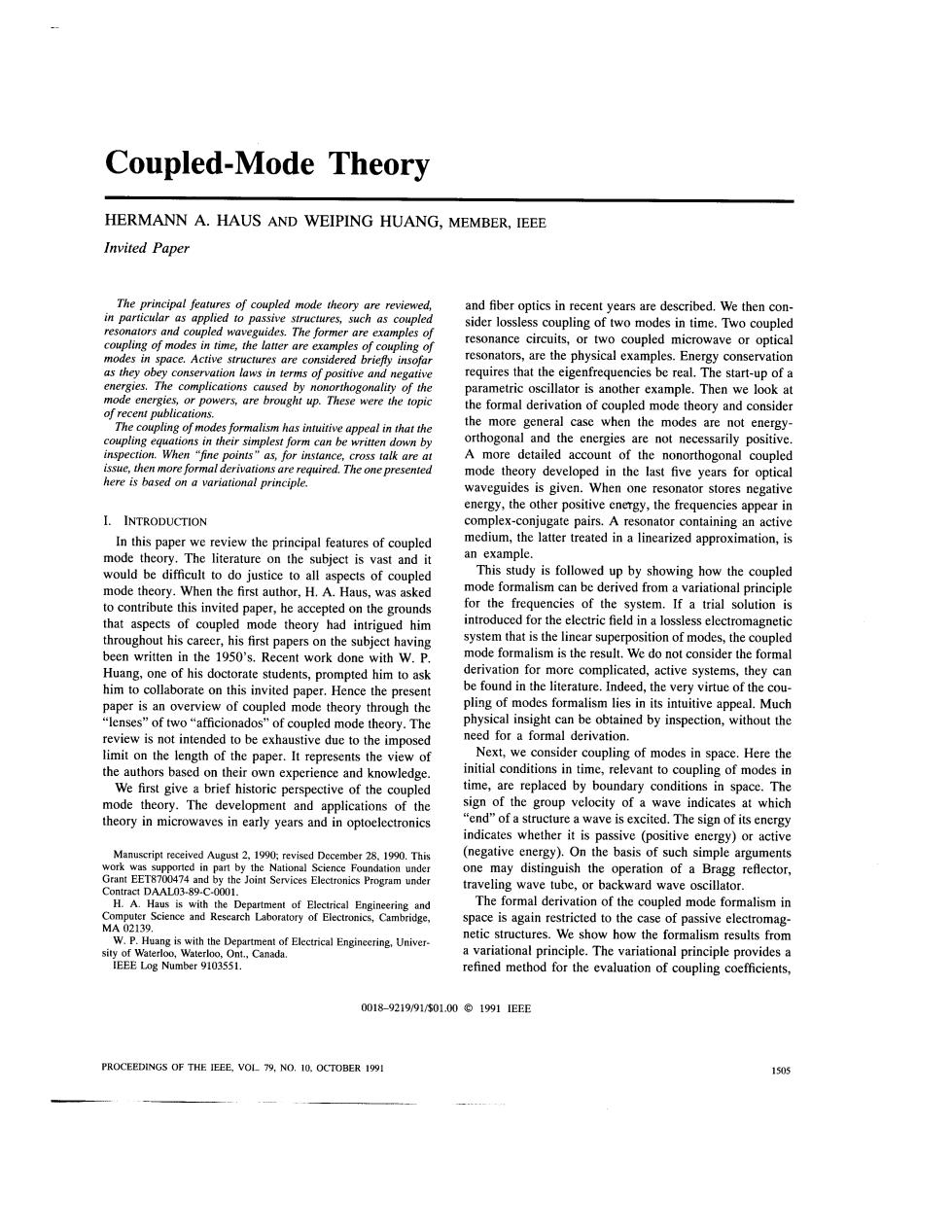正在加载图片...

Coupled-Mode Theory HERMANN A.HAUS AND WEIPING HUANG,MEMBER,IEEE Invited Paper The principal features of coupled mode theory are reviewed and fiber optics in recent years are described.We then con- in particular as applied to passive structures,such as coupled sider lossless coupling of two modes in time.Two coupled resonators and coupled waveguides.The former are examples of coupling of modes in time,the latter are examples of coupling of resonance circuits,or two coupled microwave or optical modes in space.Active structures are considered briefly insofar resonators,are the physical examples.Energy conservation as they obey conservation laws in terms of positive and negative requires that the eigenfrequencies be real.The start-up of a energies.The complications caused by nonorthogonality of the parametric oscillator is another example.Then we look at mode energies,or powers,are brought up.These were the topic of recent publications. the formal derivation of coupled mode theory and consider The coupling of modes formalism has intuitive appeal in that the the more general case when the modes are not energy- coupling equations in their simplest form can be written down by orthogonal and the energies are not necessarily positive. inspection.When "fine points"as,for instance,cross talk are at A more detailed account of the nonorthogonal coupled issue,then more formal derivations are required.The one presented mode theory developed in the last five years for optical here is based on a variational principle. waveguides is given.When one resonator stores negative energy,the other positive energy,the frequencies appear in I.INTRODUCTION complex-conjugate pairs.A resonator containing an active In this paper we review the principal features of coupled medium,the latter treated in a linearized approximation,is mode theory.The literature on the subject is vast and it an example. would be difficult to do justice to all aspects of coupled This study is followed up by showing how the coupled mode theory.When the first author,H.A.Haus,was asked mode formalism can be derived from a variational principle to contribute this invited paper,he accepted on the grounds for the frequencies of the system.If a trial solution is that aspects of coupled mode theory had intrigued him introduced for the electric field in a lossless electromagnetic throughout his career,his first papers on the subject having system that is the linear superposition of modes,the coupled been written in the 1950's.Recent work done with W.P. mode formalism is the result.We do not consider the formal Huang,one of his doctorate students,prompted him to ask derivation for more complicated,active systems,they can him to collaborate on this invited paper.Hence the present be found in the literature.Indeed,the very virtue of the cou- paper is an overview of coupled mode theory through the pling of modes formalism lies in its intuitive appeal.Much “lenses”of two“afficionados'of coupled mode theory.The physical insight can be obtained by inspection,without the review is not intended to be exhaustive due to the imposed need for a formal derivation limit on the length of the paper.It represents the view of Next,we consider coupling of modes in space.Here the the authors based on their own experience and knowledge initial conditions in time,relevant to coupling of modes in We first give a brief historic perspective of the coupled time,are replaced by boundary conditions in space.The mode theory.The development and applications of the sign of the group velocity of a wave indicates at which theory in microwaves in early years and in optoelectronics "end"of a structure a wave is excited.The sign of its energy indicates whether it is passive (positive energy)or active Manuscript received August 2,1990.revised December 28.1990.This (negative energy).On the basis of such simple arguments work was supported in part by the National Science Foundation under one may distinguish the operation of a Bragg reflector, Grant EET8700474 and by the Joint Services Electronics Program under Contract DAAL03-89-C-0001. traveling wave tube,or backward wave oscillator H.A.Haus is with the Department of Electrical Engineering and The formal derivation of the coupled mode formalism in Computer Science and Research Laboratory of Electronics,Cambridge, space is again restricted to the case of passive electromag- MA02139. W.P.Huang is with the Department of Electrical Engineering,Univer. netic structures.We show how the formalism results from sity of Waterloo,Waterloo,OntCanada. a variational principle.The variational principle provides a IEEE Log Number 9103551. refined method for the evaluation of coupling coefficients, 0018-9219/91/01.00©1991IEEE PROCEEDINGS OF THE IEEE,VOL 79,NO.10,OCTOBER 1991 1505